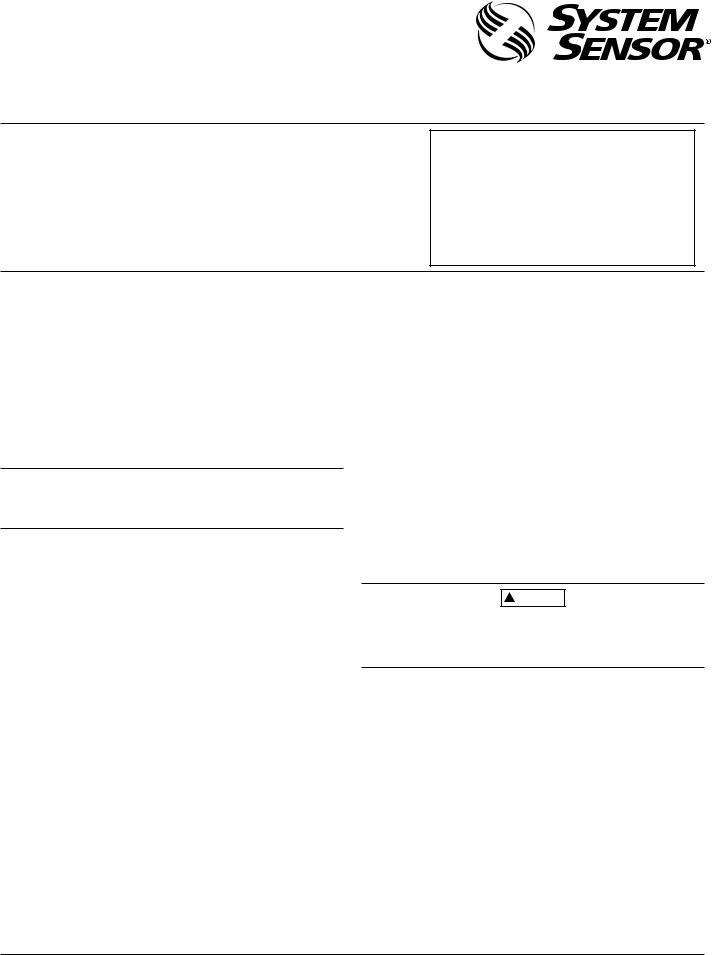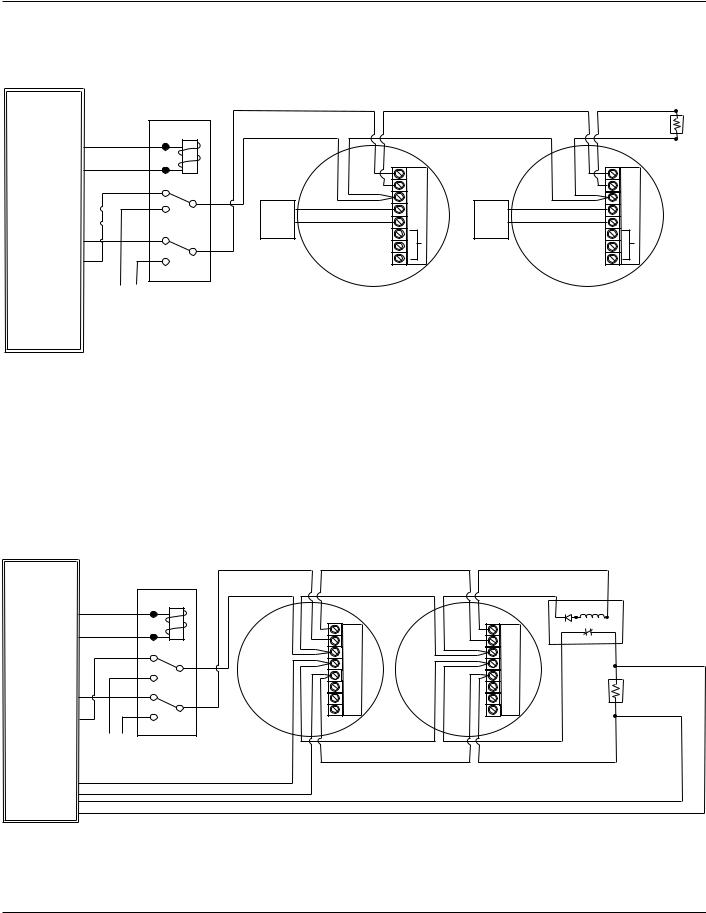System Sensor RR1 User Manual

INSTALLATION AND MAINTENANCE INSTRUCTIONS
RR1 Polarity Reversal
Relay Module
A Division of Pittway
3825 Ohio Avenue, St. Charles, Illinois 60174
1-800-SENSOR2, FAX: 630-377-6495
Specifications |
|
Operating Voltage Range: |
9.5 to 32 VDC |
Maximum Operating Current: |
29mA |
Relay Contacts: |
2A at 30 VDC, 0.5A at 120 VAC |
Operating Temperature Range: |
0˚ to 55˚ C (32° to 131° F) |
Operating Humidity Range: |
5% to 95% |
Dimensions: |
11/2² x 13/4² |
Wire connections: |
18 AWG stranded, tinned, 16² long |
NOTE: If using a power supervision relay, be aware of the following: In an alarm condition, a wiring-fault trouble state may also register at the panel when the RR1 is used.
The RR1 cannot be used with a coded (or pulsed) power supply. For proper RR1 operation, distinct wiring methods are required. See page 4 for specifics.
General Description
The RR1 polarity reversing relay module is intended for use with 2-wire and 4-wire detectors with built-in sounder, such as System Sensor 2100AT, 2112/24ATR and 2112/24AITR, and other compatible models. It is designed to allow all the detectors in the same loop to sound when one of the detectors goes into alarm.
NOTICE: This manual shall be left with the owner/user of this equipment.
NOTE: If your panel configuration does not match any of the provided wiring diagrams, please contact System Sensor technical services at 1-800-SENSOR2 for assistance.
Installation
Choose a mounting location in the control panel within reach of the provided wire leads. Use a water/isopropyl alcohol mixture (50/50) to clean the mounting surface. Allow surface to dry and remove paper backing from the Velcro and catch. Stick the Velcro in the panel and the catch on the back of the module, then mount the module inside the control panel. Route terminals to the appropriate terminals as noted below.
wire detectors.
2)Connect the red wire to other end of alarm relay contact output.
2.Connect the outgoing wires of the relay module to the smoke detector power-in terminals (brown to positive, white to negative).
3.Connect the blue and purple wires of the RR1 to any of the power sources as specified in the applicable wiring diagram (see Figures 1-4).
4.2-wire models:
Connect the yellow and orange wires to the positive and negative of the initiating loop, respectively.
4-wire models:
Connect the yellow and orange wires to the positive and negative of power to detectors, respectively.
5.Connect the smoke detector initiating circuit to the alarm loop.
 WARNING
WARNING
When calculating total current draw of the control panel, remember to add current consumption (29mA) for the power reversal relay module (RR1).
Testing
Wiring
1.Connect the relay module trigger wires to the fire alarm output terminals.
IMPORTANT: Polarity must be observed!
Before testing, notify the proper authorities that the system is undergoing maintenance and will temporarily be out of service.
A.Continuous alarm/bell output: (Figures 1 and 2) Test in accordance with NFPA 72 Chapter 7 test methods, Connect red wire to positive and black wire to negative. inspections, and testing frequency.
B.Alarm relay, normally open contact output: (Figures 3
and 4)
1)Connect one end of the alarm relay contact output and the black wire to positive and negative of power, respectively. Auxiliary power supply is used as a power source for 2-wire detectors and power to the detectors is used as a power source for 4-
1.To test the RR1 module, confirm that the smoke detectors do not sound without an alarm.
2.Initiate an alarm with smoke or approved test method on any detector connected to the control panel via the RR1 module. In alarm, all the detectors that are installed in the corresponding loop shall sound.
3.Reset the detectors by removing power to the loop.
M500-12-00 |
1 |
I56-1168-02 |

NOTE: If your panel configuration does not match any of the following wiring diagrams, please contact System Sensor technical services at 1-800-SENSOR2 for assistance
Figure 1. RR1 module with 2-wire smoke detectors:
The power reversal relay module does not provide supervision.
All supervision is provided by the interconnected control unit.
UL LISTED |
|
POWER REVERSAL |
|
|
|
|
|
|
CONTROL |
|
|
|
|
|
|
||
|
RELAY MODULE (RR1) |
|
|
|
|
|
||
PANEL |
|
|
|
|
|
|
||
|
|
|
|
|
|
|
EOL |
|
|
|
|
|
|
|
|
|
|
CONTINUOUS |
RED |
T1 |
|
|
|
|
|
|
BELL/ |
+ |
|
|
|
|
|
|
|
ALARM |
|
|
|
|
|
|
|
|
OUTPUT |
– |
BLK |
|
|
+ |
|
|
+ P |
|
|
T2 |
|
P |
|
|||
|
|
|
|
|
||||
|
|
ORG |
T8 |
|
+ |
W |
|
+ W |
|
|
BLUE |
T7 |
+ |
– R |
+ |
– R |
|
|
|
WHITE |
A+ |
|
A+ |
|||
|
|
|
|
|||||
|
|
|
T6 |
– |
A- |
|
– |
A- |
|
|
|
|
|
||||
INITIATING |
+ |
|
T3 |
RA400Z |
|
Not |
RA400Z |
Not |
|
YELLOW |
|
|
Used |
Used |
|||
LOOP – |
|
T4 BROWN |
|
|
|
|
|
|
|
|
PURPLE T5 |
|
|
|
|
|
|
+
 –
–
To auxiliary power/IAC/Bell output or any UL listed regulated power supply listed for fire protective signaling use. (polarity shown with panel in alarm).
A78-2336-10
NOTE: If optional Class A wiring is used, second power reversal relay module (RR1) must be added to enable concurrent loop polarity reversal.
Figure 2. RR1 module with 4-wire smoke detectors:
UL LISTED
CONTROL
PANEL
CONTINUOUS BELL/ + ALARM OUTPUT –
POWER + TO
DETECTORS –
INITIATING
LOOP
The power reversal relay module does not provide supervision.
All supervision is provided by the interconnected control unit.
POWER REVERSAL
RELAY MODULE (RR1)
RED |
T1 |
|
|
BLK |
|
|
+ P |
|
T2 |
|
+ W |
ORG |
T8 |
|
– R |
|
T7 |
|
A |
BLUE |
WHITE |
A |
|
|
T6 |
|
NC A |
|
T3 |
|
|
|
|
C U |
|
YELLOW |
|
|
|
|
|
NO X |
|
|
T4 |
BROWN |
|
|
|
||
PURPLE T5 |
|
|
|
+ 
 –
–
To auxiliary power/detector power/IAC/Bell output or any UL listed regulated power supply listed for fire protective signaling use.
(polarity shown with panel in alarm).
OPTIONAL CLASS A WIRING
|
|
EOL POWER |
|
|
|
SUPERVISION |
|
|
|
RELAY (SHOWN |
|
+ |
P |
ENERGIZED) |
|
+ W |
A77-716 12/24V |
||
|
|||
– R |
|
||
A |
} INITIATING |
|
|
A |
LOOP |
EOL RESISTOR |
|
NC A |
|||
SPECIFIED BY |
|||
C |
U |
PANEL |
|
NO X |
MANUFACTURER |
||
A78-2336-09
M500-12-00 |
2 |
I56-1168-02 |
